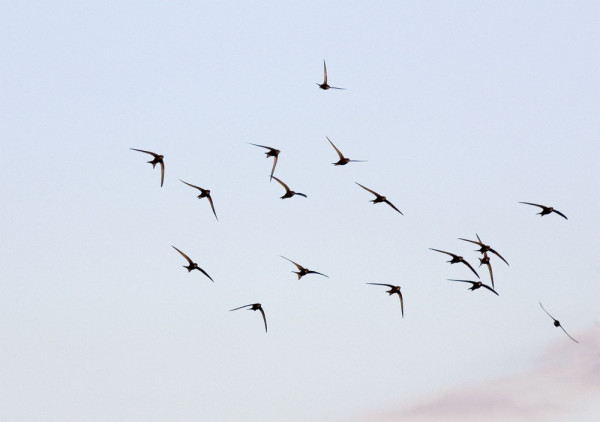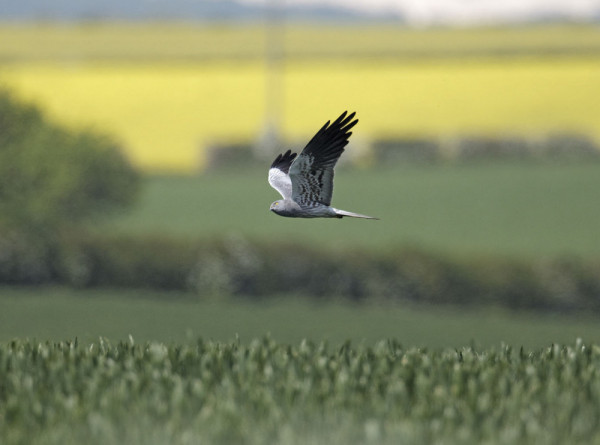
Migration Blog (23rd April – 29th April)
With spring migration in full swing, what should we be looking out for in the coming week?
Over the last seven days it certainly feels like migration has stepped up a gear. More birds of an increasing diversity of species have arrived in the UK either to breed or to stop off on their way to breeding grounds further north. Even with the restrictions in place many people have been able to witness the changing range of species as more arrive and we progress towards summer. The dawn chorus has new participants each bringing their own tune to the mix, and even in urban areas the odd surprise can be heard with Willow, Sedge and even Grasshopper Warbler being heard from a few gardens.
A fresher feel to the temperature, especially in the east of the county, didn't seem to curtail spring migration as increasing numbers of Whitethroats, Redstarts, Willow Warblers, Garden Warblers, House Martins, Swallows, and Cuckoos were noted across the country. Over the last couple of days several sites, mainly in the northern half of England, saw good numbers of Arctic Terns passing through, with one site in Lancashire recording 681 birds. These sightings weren't restricted to reservoirs or lakes; some inland sites recorded Arctic Terns flying over in small groups calling as they passed over. As with Osprey, Arctic Terns can take a fairly direct route through the UK rather than skirt around the coast, but for a bird that migrates around 22,000 km we can let them off taking the direct route. Mixed in with these were the occasional Black Tern and Little Gulls, both of which are passage migrants in the UK rather than a regular breeding species.
Scarcer species noted over the last week included the predicted Woodchat Shrike from the last blog, with a bird in Dorset, and also the predicted Subalpine Warbler (one on the Shetland Isles and one on Ramsey Island both of which were of the Eastern form), an early Citrine Wagtail in Cumbria, and yet more Hoopoes which turned up from the Isles of Scilly right up to the Shetland Isles. Scarce herons were represented by a couple each of Purple Heron, in Dorset and Suffolk, and Night-Herons on the Isles of Scilly and a young bird in Hampshire. It can only be a matter of time before the latter species breeds in the UK on a regular basis.

Species focus - Swift
Swifts are made for flying and do just that, spending most of their life on the wing. The oldest Swift BTO has on record reached the ripe old age of 17 years, 11 months and 5 days – it is difficult to imagine how many miles that birds flew during its life.
Thanks to new technology we now know that Swifts spend part of the winter months in the Congo basin before moving east into Mozambique. From here they begin their return journey back to the UK, spending time back in the Congo basin before heading across the Gulf of Guinea – a 2-3 day sea crossing - before making landfall in Liberia. After staging in Liberia they undertake a pretty rapid northerly migration back to the UK. The complete migration is a round journey of around 22,000 km. That means our oldest Swift flew around 400,000 km just on migration.
It is estimated that the UK breeding population is around 59,000 pairs, but the population has been declining, down by 57% since 1995. Swift is amber-listed as a Bird of Conservation Concern.
Swifts seem to arrive back in the UK all at once during the last week of April or the first few days of May – this year their arrival seems particularly early, almost certainly a result of the warm south and south-easterly airflow we have been enjoying during the last few weeks.
Weather for the week ahead
So far this spring the weather has been kind to those birds that migrate up the west coast of Africa into Spain and northwards, and this continued fine weather looks set to continue with only a brief spell of northerly winds towards the middle of next week looking likely to slow migration ever so slightly. The clear sunny days will allow birds to continue their migration and the next week sees the peak BirdTrack reporting rates for Whimbrel, Lesser Whitethroat, Nightingale and Redstart. Whilst the Lesser Whitethroats, Nightingales and Redstart are likely to be UK breeders, the breeding population of Whimbrel in the UK has been declining and most of the birds seen at this time of year are likely to be Icelandic breeders. Their trilling call, similar to the giggling call of Little Grebe, is a good way of locating birds as they fly over. Indeed this is a species even landlocked observers could encounter from their home; they will also migrate at night so are a real possibility for those doing nocmig recording.
Given the predicted weather and the time of year the list of possible scarce and rare species that could turn up is a long one and adds to the excitement of what could be seen.
This next week also looks good for Yellow Wagtails to arrive. Cattle fields are always a good place to look for these. Common Terns and the first Little Terns will also be arriving and they could be joined by more Black Terns and Little Gulls given the light easterly winds we will be getting. Garden Warblers, whose song is very similar to that of the Blackcap, arrive later than most warblers and the next couple of weeks should see more birds arriving. You can learn how to distinguish their song from that of Blackcap here .

Given the predicted weather and the time of year the list of possible scarce and rare species that could turn up is a long one and adds to the excitement of what could be seen. Clear sunny days are great for raptors and Black Kites are a good bet at this time of year, but make sure you eliminate a migrating female or immature Marsh Harrier that can look similar when seen at range. Montagu's Harriers will also be arriving at this time of year. This very rare breeding bird has a toehold in the UK with only a handful of pairs breeding each year. Any sightings of this species, especially if they are showing signs of breeding should be submitted to BirdTrack, as these can then be passed to the Rare Breeding Birds Panel who monitor all scarce and rare breeding birds in the UK. If you are fortunate enough to spot a Harrier at this time of year, it is also worth eliminating Pallid Harrier as the occasional spring bird has been recorded over the past few years due to the population expanding their range westwards. If you are able to get to the coast as part of your daily exercise then mid-late April is a good time to look for Pomarine Skuas as they head to the Arctic to breed. Many birds at this time of year will also be in full breeding plumage and sport their amazing spoon-shaped tail feathers. Other scarcities to be on the lookout for include Whiskered Tern, Red-rumped Swallow, Subalpine Warbler, Woodchat Shrike, Citrine Wagtail and Iberian Chiffchaff. Iberian Chiffchaffs are best located by their song which is distinct and has a flurry towards the end unlike the normal 'chiff-chaff' song of common Chiffchaff. Scarce subspecies of Yellow Wagtail are also a real possibility with Black-headed and Grey-headed Wagtails both likely in late April into early May.







Share this page